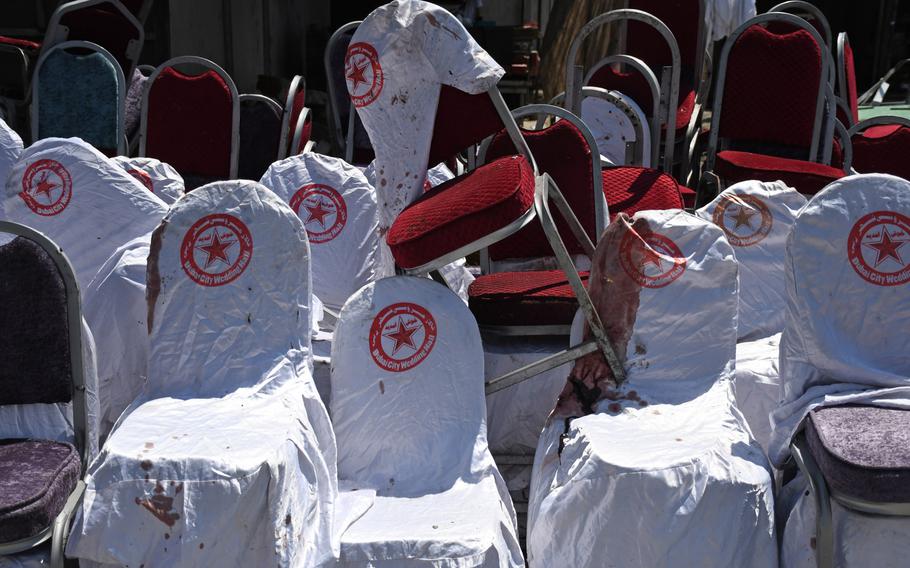
Blood-stained chairs are stacked outside the Dubai City Wedding Hall in Kabul on Aug. 18, 2019, a day after a suicide attack at the venue killed dozens of people. More Afghans were killed in the third quarter of 2019 than any comparable time period in the past decade, according to a U.N. report released Oct. 17, 2019. (Phillip Walter Wellman/Stars and Stripes)
KABUL, Afghanistan — More Afghans were killed or injured in the last three months than in any comparable period in the last decade, the United Nations said in a report released Thursday, blaming the Taliban for most of the deaths.
The deaths and injuries in Afghanistan came as the U.S. and the Taliban had accelerated peace talks, which collapsed in September soon after the Taliban claimed an attack that killed a U.S. soldier.
From July to September, 1,174 civilians were killed and more than 3,100 were injured, the report said. The tally for the quarter was the highest since the U.N. began tracking civilian deaths in Afghanistan 10 years ago.
Over 40% of this year’s civilian casualties were women and children, the U.N. report said.
“The impact of Afghanistan’s conflict on civilians is appalling; every verified number is a person, someone’s relative – mother, father, daughter, son,” said Fiona Frazer, UNAMA’s human rights chief.
This quarter’s rise in civilian casualties was blamed mainly on bomb attacks carried out by the Taliban, followed by ground engagements and aerial attacks, the report said.
During the first nine months of 2019, the Taliban and Islamic State group were responsible for more than 60% of civilian deaths and injuries, while pro-government forces were blamed for just over a quarter of the casualties, the report said. Some casualties were not attributed to either side.
Attacks by extremist groups also caused more civilian deaths in the third quarter than operations by pro-government forces, the report said.
Airstrikes, mostly conducted by American forces, still caused nearly a quarter of all civilian deaths in Afghanistan in 2019, the report said.
The latest civilian casualty figures were released just days after the 18th anniversary of the war. Earlier in the week, the U.N. released a separate report condemning the Taliban for using violence and intimidation to disrupt Afghanistan’s Sept. 28 presidential election.
At least 85 civilians were killed and over 370 injured in attacks carried out mainly by the Taliban on election day and during the campaign period, the U.N. said.
The threat of violence may have contributed to low voter turnout, which could lead some to question the polls’ legitimacy, government officials and analysts have said.
After talks between American and Taliban officials collapsed last month, President Donald Trump vowed “to hit our enemy harder” than ever before, raising fears among some Afghans that even more civilians would get caught up in the country’s chronic violence.
In another report released last week, the U.N. said American airstrikes targeting drug production facilities in western Afghanistan in May left nearly 40 civilians dead or injured.
The U.N. said the airstrikes were unlawful because the facilities that were hit were civilian targets under international law.
United States Forces-Afghanistan denied the claims of illegality and that the strikes caused casualties.
“USFOR-A is deeply concerned by UNAMA’s methods and findings,” command spokesman Col. Sonny Leggett said on Twitter shortly after the report was released, using an acronym for the U.N.’s mission in Afghanistan. “Sources with limited information, conflicted motives and violent agendas are not credible.”
The two sides have long disagreed over civilian casualty numbers.
The U.S. military primarily relies on overhead surveillance to determine whether civilians were killed or injured by its strikes, while the U.N. uses on-the-ground fact-finding teams to interview witnesses. Critics of the military’s method say it is sometimes impossible to identify casualties without being on the ground.
wellman.phillip@stripes.com Twitter: @pwwellman